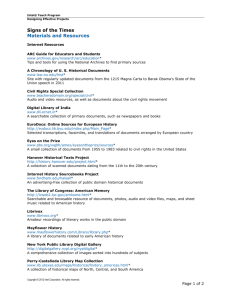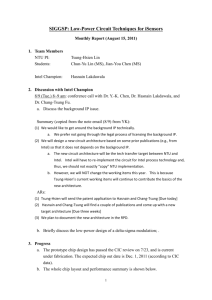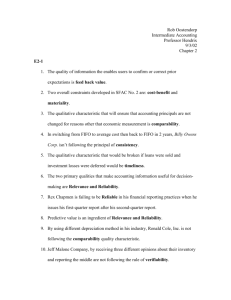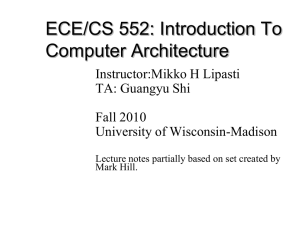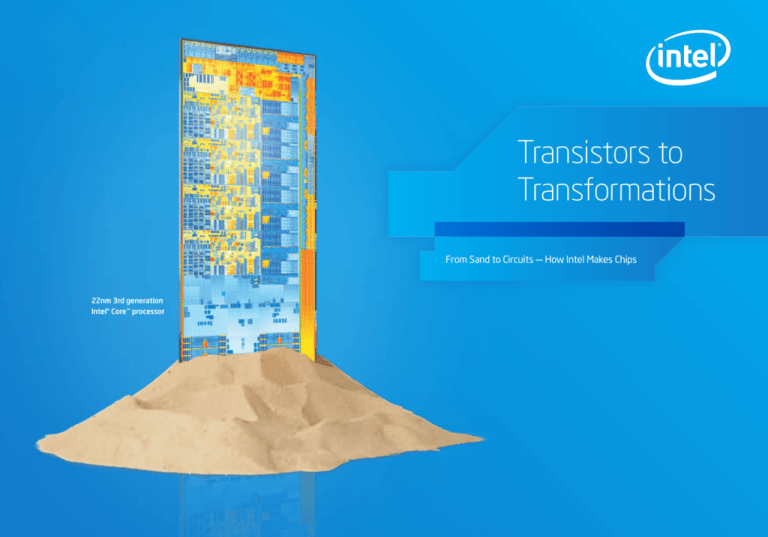
Transistors to
Transformations
From Sand to Circuits — How Intel Makes Chips
22nm 3rd generation
Intel® Core™ processor
“For years we have see
transistors can get. Th
structure is a truly rev
and one that should all
the historic pace of inn
-Gordon E. Moore, Co-founder, Intel Corporation, commenting on Intel’s radical reinvention of the transistor — the creation of the 22nm 3-D Tri-Gate transistor
n limits to how small
is change in the basic
olutionary approach,
ow Moore’s Law and
ovation to continue.”
A Smart World
REVOLUTIONARY
For decades, Intel’s research and development,
advanced silicon chips, and manufacturing
have brought together the best of computing,
communications, and consumer electronics to
enable valuable benefits from technology.
Intel continues to introduce new process
technologies that deliver more energy-efficient,
secure, and higher-performance products, which
are then designed into your increasingly connected,
smarter devices.
THE POWER TO TRANSFORM
Delivering Moore’s Law requires numerous
innovations. Intel’s world-first, advanced transistor
design introductions include strained silicon (2003),
45nm with high-k/metal gate silicon technology
(2007), followed by the 32nm 2nd generation
high-k/metal gate silicon technology (2009).
Recently, Intel introduced another radical design
change—22nm 3-D Tri-Gate transistors (2011),
which entered high-volume production in 2012.
From Ultrabook™ devices, data centers, and high
performance computing, to applications, security,
and Intel-powered smartphones and tablets, the
only thing more amazing than Intel’s technology is
what you do with it.
YOUR WORLD CONNECTED
MOORE’S LAW
According to Moore’s Law, the number of
transistors on a chip roughly doubles every
couple of years. As a result, the transistor scale
gets smaller and smaller. As the transistor count
climbs, so does the ability to integrate more
capabilities onto a chip and increase device
complexity.
The cumulative impact of these spiraling increases
in capabilities enables today’s mobile devices, fuels
the increasingly Internet-connected and
information-rich digital experiences we seek,
and powers industries and our global economy.
“Our vision is very simple: if it consumes electricity,
it’s going to end up computing, and if it’s computing,
it will be connected to the Internet,” stated Kirk B.
Skaugen, Intel Vice President and General Manager
of the PC Client Group. He was describing server
cloud computing capabilities and connected device
growth expected within the next decade at the
Web 2.0 Summit in November 2011.
Forecasts call for 15 billion connected devices1 and
over three billion connected users2 by 2015. The
growth of global data through 2015 is expected to
surpass 4.8 zettabytes per year.3 At these levels,
each connected user will generate more than four
GB of data traffic every day. That’s the equivalent
of a 4-hour HD movie.
Find definitions of italicized words in the “Terminology”
section at the end of this brochure.
2012
*
2010*
2008
*
Intel® Core™2 Duo processor die
(45nm high-k/metal gate silicon technology)
Die not shown to scale.
*Date of high volume production
2nd generation Intel® Core™ processor die
(32nm process technology)
3rd generation Intel® Core™ processor die
(manufactured on industry-leading 22nm process
technology with 3-D Tri-Gate transistors)
ADVANCED DESIGN
HOW CHIPS WORK
Intel creates industry-leading and world-first
silicon products that introduce more capabilities,
are smaller, more powerful, and use less energy.
While advancing technology, Intel incorporates
environmental principles into each step of the
product life cycle. And by anticipating the needs for
the next generation, Intel’s success at advanced
chip design has helped drive other innovations in
almost all industries.
The way a chip works is a result of how a chip’s
transistors and gates are designed and the
use of the chip. A chip can contain millions or
billions of transistors interconnected in a certain
manner. These transistors act as switches, either
preventing or allowing electrical current to pass
through. A gate turns the transistors on and off,
allowing electrical currents to send, receive, and
process digital data (1s and 0s) as instructions and
information. Chips today can have multiple cores.
WHAT IS A CHIP?
A chip, also known as a die or processor, is a
microelectronic device that can process information
in the form of electrical current traveling along a
circuit. Although they look flat, today’s chips may
have more than 30 layers of complex circuitry
compared to five layers on the 4004, Intel’s first
processor, introduced in 1971.
THE ULTIMATE PUZZLE
How would you organize something with
1,000,000,000 pieces, and then create a plan
so it can be put together correctly and on time?
Worldwide teamwork is critical. Precision counts.
Rules matter. Many types of engineers work closely
together to design chips and translate circuit
schematics into mask layers for manufacturing.
Before Intel makes chips, engineers ensure the
accuracy of the specification. They begin with a
design or blueprint and consider many factors:
What type of chip is needed and why? How many
transistors can be built on the chip? What is the
optimal chip size? What technology will be available
to create the chip? When does the chip need to
be ready? Where will it be manufactured and
tested? To answer these questions, Intel teams
work with customers, software companies, and
Intel’s marketing, manufacturing, and testing staff.
The design teams take this input and begin the
monumental task of defining a chip’s features
and design.
When the specifications for the chip are ready, Intel
creates a logic design, an abstract representation
of the hundreds of millions of transistors and
interconnections that control the flow of electricity
through a chip. After this phase is complete,
designers prepare physical representations of
each layer of the chip and its transistors. They
then develop stencil-like patterns, or masks, for
each layer of the chip that are used with ultraviolet
(UV) light during a fabrication process called
photolithography.
To complete the design, testing, and simulation of
a chip, Intel uses computer-aided design (CAD)
tools. CAD helps designers create very complex
designs that meet functional, performance, and
power goals. After extensive modeling, simulation,
and verification, the chip is ready for fabrication.
It can take hundreds of engineers working multiple
years to design, test, and ready a new chip design
for fabrication.
INTEL ENVIRONMENTAL,
HEALTH, & SAFETY
PRODUCT LIFE CYCLE
From initial research to the end of a product’s life,
Intel integrates environmental principles and
health and safety practices into each stage.
02
MATERIALS &
EQUIPMENT SELECTION
Process equipment safety
Restriction of Hazardous
Substances (RoHS) compliance
03
CHEMICAL USE
APPROVAL
Toxicity screening
Electronic Industry
Citizenship Coalition
Material screening tool
Product specs
Hazard classification
01
RESEARCH &
DEVELOPMENT
Risk evaluation
Substitution alternatives
Control mechanism
Personal protective equipment
Benign semiconductor materials
Design for the Environment Principles
Nanotech research
06
END OF LIFE
04
INTEL
OPERATIONS
Community recycling events
Environmental Protection
Agency (EPA) Plug-In to eCycling
Resource conservation
International Organization for
Standardization (ISO) 14001
Climate-change footprint
Employee safety and wellness
Waste reduction and recycling
Electronic Product Environmental
Assessment Tool (EPEAT)
05
INTEL
PRODUCTS
Energy efficiency
RoHS compliance
Product packaging reduction
Energy Star*
Halogen-free 4
Lead-free5
Power-supply energy specifications
Power management software
Environmental education
Waste Electrical and Electronic
Equipment (WEEE) Directive
Global. Connected.
Mission Critical.
Intel’s manufacturing leadership includes a global network of high-volume,
technically advanced wafer fabrication facilities, or fabs, that run 24 hours
a day, 7 days a week, 365 days a year.
FABRICATION
The process of making chips is called fabrication.
Inside Intel’s ultra-clean fabs, the world’s most
complex, tiniest machines — processors and other
silicon chips — are built in a sustainable manner.
Intel fabs are among the most technically advanced
manufacturing facilities in the world. Within these
sophisticated fabs, Intel makes chips in a special
area called a cleanroom.
Because particles of dust can ruin the complex
circuitry on a chip, cleanroom air must be ultraclean. Purified air is constantly recirculated,
entering through the ceiling and exiting through
floor tiles. Technicians put on a special suit,
commonly called a bunny suit, before they enter a
cleanroom. This helps keep contaminants such as
lint and hair off the wafers.
In a cleanroom, a cubic foot of air contains less than
one particle measuring about 0.5 micron (millionth
of a meter) across. That’s thousands of times
cleaner than a hospital operating room.
Automation has a critical role in a fab. Batches of
wafers are kept clean and are processed quickly
and efficiently by traveling through the fab inside
front-opening unified pods (FOUPs) on an
overhead monorail. Each FOUP receives a barcode
tag that identifies the recipe that will be used to
make the chips inside. This labeling ensures the
correct processing at each step of fabrication. Each
FOUP contains up to 25 wafers and weighs more
than 25 pounds. Production automation machinery
allows for this FOUP weight, which is too heavy to
be handled manually by technicians.
Above: 3rd generation Intel® Core™ wafer
Top left: Orange FOUPs carry 300mm wafers in an automated fab.
Top right: Highly-trained technicians monitor each phase of chip fabrication.
Bottom left: Purified air enters from the ceiling and exits through perforated floor tiles.
Bottom right: The 32nm planar transistor (on left) illustrates current (represented by yellow dots)
flowing in a flat plane under the gate, while Intel’s smaller 22nm 3-D Tri-Gate transistor (on right)
illustrates increased current flow over three sides of a vertical fin.
How Intel Makes Chips
SAND TO INGOT
INGOT TO WAFER
PHOTOLITHOGRAPHY
Sand
Slicing Ingots
Applying Photoresist
Sand has a high percentage of silicon—the
starting material for computer chips. Silicon is a
semiconductor, meaning that it can be turned into
an excellent conductor or insulator of electricity
with minor amounts of impurities added.
The ingot is cut into individual silicon discs called
wafers. Each wafer is about one mm thick.
Photolithography is a process that imprints a
specific pattern on the wafer. It starts by applying
a light-sensitive, etch-resistant material called
photoresist onto the wafer surface.
Melted Silicon
Silicon is purified to less than one alien atom per
billion. It is melted and cooled into a solid crystal
lattice cylinder, called an ingot.
Monocrystalline Silicon Ingot
The silicon ingot has a diameter of 300 millimeters
(mm) and weighs about 100 kilograms (kg).
Polishing Wafers
The wafers are polished to a flawless,
mirror-smooth surface. Intel buys these
manufacturing-ready wafers.
Exposing Photoresist
The photoresist is hardened and parts of it are
exposed to ultraviolet light, making it soluble. The
light passes through a mask (similar to a stencil),
and then through a lens to shrink and print circuit
patterns on each layer of every chip on the wafer.
Developing Resist
A chemical process removes the soluble
photoresist, leaving a patterned photoresist
image as determined by what was on the mask.
CHIPS ARE THREE-DIMENSIONAL STRUCTURES
built simultaneously on batches of wafers in a
fab. Making chips is a complex process requiring
hundreds of precisely controlled steps that
result in patterned layers of various materials
built one on top of another. These layers form
the circuits, which include electrical pathways
and transistors (switches). Follow some of the
key steps illustrating Intel’s chip manufacturing
process for the 22nm 3rd generation Intel®
Core™ processors.
ION IMPLANTATION
ETCHING
TEMPORARY GATE FORMATION
Implanting Ions
Etching
Creating a Gate Dielectric
Ions (positively or negatively charged atoms)
are embedded beneath the surface of the
wafer in regions not covered by photoresist.
This alters the conductive properties of the
silicon in selected locations.
To create a fin for a tri-gate transistor, Intel applies
a hard mask material (blue in the image) using
photolithography. Then a chemical is applied to etch
away unwanted silicon, leaving behind a fin with a
layer of hard mask on top.
Photoresist is applied to portions of the transistor,
and a thin silicon dioxide layer (red in the image) is
created by inserting the wafer in an oxygen-filled
tube-furnace. This layer becomes a temporary gate
dielectric.
Removing Photoresist
Removing Hard Mask
Creating a Gate Electrode
After the ion implantation, the photoresist is
removed, resulting in certain regions being doped
The hard mask is chemically removed, leaving a
tall, thin silicon fin that will contain the channel of
a transistor.
Using photolithography, a temporary layer of
polycrystalline silicon (yellow in the image) is
created. This becomes a temporary gate electrode.
with alien atoms (green in the image).
The Transistor
Although hundreds of chips are usually built on a
single wafer, the next steps focus on a small piece
of a chip—a transistor.
Insulating the Transistor
In another oxidation step, a silicon dioxide layer
is created over the entire wafer (transparent
red in the image) to insulate the transistor from
other elements.
How Intel Makes Chips
“GATE-LAST” HIGH-K/METAL
GATE FORMATION
Removing the Temporary Gate
The temporary gate electrode and gate dielectric
are etched away in preparation for forming the
final gate. This procedure is called gate-last.
Applying High-k Dielectric Material
Multiple layers of high-k dielectric material
(yellow in the image) are applied to the wafer
surface using a method called atomic layer
deposition. This material is etched away in some
areas, such as the silicon dioxide layer.
Forming a Metal Gate
A metal gate electrode (blue in the image) is
formed over the wafer and removed from regions
other than the gate electrode. The combination
of this and the high-k dielectric material improves
performance and reduces leakage.
METAL DEPOSITION
METAL LAYERS
Preparing to Connect the Transistor
Polishing
Three holes are etched into the insulation layer
(red in the image) above the transistor. The holes
are filled with copper or another material that
creates metal connections to other transistors.
The excess material is polished off, revealing
a specific pattern of copper.
Electroplating
The wafers are put into a copper sulphate solution.
Copper ions are deposited onto the transistor using
a process called electroplating.
After Electroplating
Copper ions settle as a thin layer of copper on the
transistor surface.
Connecting with Metal Layers
Like a multi-level highway, metal layers
interconnect the transistors in a chip
(middle and right images). The design of
the chip determines how the connections are
made. Although chips look flat, they can have
more than 30 layers of this complex circuitry.
WAFER SORT TEST
AND SINGULATION
PACKAGING DIE
Sort Testing
The silicon die shown here is a 3rd generation Intel®
Core™ processor, Intel’s first 22nm microprocessor
using 3-D transistors.
After wafer processing is complete, each chip
on a wafer is tested for its functionality.
Slicing Wafers
The wafer is cut into pieces called die.
Moving to Packaging
Based on the responses received in the wafer
sort test, die are selected for packaging.
Individual Die
Packaging
The substrate, the die, and a heat spreader are put
together to form a completed processor. The green
substrate creates the electrical and mechanical
connections so that the processor can interact
with the system. The silver-colored heat spreader
is a thermal interface that helps dissipate heat.
Completed Processor
A completed processor, such as the 3rd generation
Intel Core processor, is one of the most complex
manufactured products on Earth.
CLASS TESTING AND
COMPLETED PROCESSOR
Package Testing
Processors undergo final testing for functionality,
performance, and power.
Binning
Based on final test results, processors with the
same capabilities are grouped into transporting
trays.
Retail Packaging
Intel® processors, such as the 3rd generation
Intel Core processor shown here, are sent to
system manufacturers in trays, or they are
boxed for retail stores.
Intel Chips
Throughout Intel’s history, new and improved technologies
have transformed the human experience.
1971
1972
1974
1978
1982
Intel® 4004 processor
Initial clock speed: 108KHz
Transistors: 2,300
Manufacturing technology:
10 micron
Intel® 8008 processor
Initial clock speed: 800KHz
Transistors: 3,500
Manufacturing technology:
10 micron
Intel® 8080 processor
Initial clock speed: 2MHz
Transistors: 4,500
Manufacturing technology:
6 micron
Intel® 8086 processor
Initial clock speed: 5MHz
Transistors: 29,000
Manufacturing technology:
3 micron
Intel® 286 processor
Initial clock speed: 6MHz
Transistors: 134,000
Manufacturing technology:
1.5 micron
1997
1998
1999
2000
2001
Intel® Pentium® processor
Initial clock speed: 300MHz
Transistors: 7.5 million
Manufacturing technology:
0.25 micron
Intel® Celeron® processor
Initial clock speed: 266MHz
Transistors: 7.5 million
Manufacturing technology:
0.25 micron
Intel® Pentium® III processor
Initial clock speed: 600MHz
Transistors: 9.5 million
Manufacturing technology:
0.25 micron
Intel® Pentium® 4 processor
Initial clock speed: 1.5GHz
Transistors: 42 million
Manufacturing technology:
0.18 micron
Intel® Xeon® processor
Initial clock speed: 1.7GHz
Transistors: 42 million
Manufacturing technology:
0.18 micron
Die not shown to scale.
Decades of Intel chips, including the 22nm 3rd generation Intel® Core™ processor with its revolutionary
3-D Tri-Gate transistors, illustrate Intel’s unwavering commitment to delivering technology and manu­
facturing leadership to the devices you use every day. As you advance through the chart, the benefits
of Moore’s Law, which states that the number of transistors roughly doubles every couple of years,
are evident as Intel increases transistor density and innovates the architecture designs that deliver
more complex, powerful, and energy-efficient chips that transform the way we work, live, and play.
1985
1989
1993
1995
Intel386™ processor
Initial clock speed: 16MHz
Transistors: 275,000
Manufacturing technology:
1.5 micron
Intel486™ processor
Initial clock speed: 25MHz
Transistors: 1.2 million
Manufacturing technology:
1 micron
Intel® Pentium® processor
Initial clock speed: 66MHz
Transistors: 3.1 million
Manufacturing technology:
0.8 micron
Intel® Pentium® Pro processor
Initial clock speed: 200MHz
Transistors: 5.5 million
Manufacturing technology:
0.35 micron
2003
2006
2008
2008
2010
2012
Intel® Pentium® M processor
Initial clock speed: 1.7GHz
Transistors: 55 million
Manufacturing technology:
90nm
Intel® Core™2 Duo processor
Initial clock speed: 2.66GHz
Transistors: 291 million
Manufacturing technology:
65nm
Intel® Core™2 Duo processor
Initial clock speed: 2.4GHz
Transistors: 410 million
Manufacturing technology:
45nm
Intel® Atom™ processor
Initial clock speed: 1.86GHz
Transistors: 47 million
Manufacturing technology:
45nm
2nd generation
Intel® Core™ processor
Initial clock speed: 3.8GHz
Transistors: 1.16 billion
Manufacturing technology:
32nm
3rd generation
Intel® Core™ processor
Initial clock speed: 2.9GHz
Transistors: 1.4 billion
Manufacturing technology:
22nm
This Next Decade
Intel will create and extend computing technology to connect and enrich the
lives of every person on Earth. We believe fundamentally that computing
technology will have a positive impact on every individual, business, and
community around the world.
NEW LEVELS OF SECURITY
THE ULTIMATE MOBILE DEVICE
THE HEART OF INNOVATION
The full benefits of technology can only be realized
when the computing experience is secure—when
individuals can be certain that personal information
remains personal, and when businesses can ensure
that data and systems integrity is never breached.
Intel Capital is investing to help accelerate
innovation and the adoption of new technology and
services in the automotive industry. The funding is
part of Intel’s ongoing work with automakers and
in-vehicle infotainment suppliers to help integrate
advanced technologies into cars. Ultimately, the
connected car will have the intelligence and context
awareness to offer the right information, at the
right time, and in the right way to keep drivers and
passengers informed, entertained, and productive
while maintaining optimal safety. A connected
car could then communicate with the cloud, the
transportation infrastructure, and even other
vehicles to provide additional services such as
advanced driver assistance and real-time traffic
information to optimize the flow of traffic.
Throughout Intel’s history, we have pushed the
boundaries of what’s possible. Our vision for
the next decade is even more ambitious.
To enable this vision, Intel is delivering a new level
of security that builds protection and safety into
the heart of computing technology. From silicon, to
software, to services, Intel is building security into
everything we do.
One example is the Ultrabook, which delivers a safer
experience with security technology features built
into the chip. Intel® Anti-Theft6 and Intel® Identity
Protection7 technologies, coupled with software and
services, protect your identity and data for greater
peace-of-mind.
Intel believes that education, innovation, and
entrepreneurship are the keys to driving economic
growth and improving social conditions. Skills such
as digital literacy, problem solving, critical thinking,
and collaboration are best developed in active
learning environments supported by technology
to inspire the next generation.
At the heart of what
is possible is innovation
and imagination.
22nm 3-D Tri-Gate transistor
Intel’s 3-D Tri-Gate transistor uses three gates wrapped
around the silicon channel in a 3-D structure, enabling
an unprecedented combination of performance and
energy efficiency. Intel designed the new transistor to
provide unique, ultra-low power benefits for use in
handheld devices, like smartphones and tablets, while
also delivering improved performance normally expected
for high-end processors.
Channel
The region under the gate of a transistor where current
flows when the transistor is in the “on” state.
Chip
A tiny, thin square or rectangle that contains integrated
electronic circuitry. Die are built in batches on wafers
of silicon. A chip is a packaged die. Chips are also called
processors and microprocessors. Microprocessors are the
brains of computers, servers, communications products,
and other digital devices.
Circuit
A network of transistors interconnected by wires in a
specific configuration to perform a function.
Cleanroom
The ultra-clean room where chips are fabricated.
Cleanroom air is thousands of times cleaner than that in a
typical hospital operating room.
Computer-aided design (CAD)
Computerized workstations and software used to design
integrated circuits.
Die
Alternate name for a chip, usually before it is packaged.
See also Chip.
Etching
The removal of selected portions of materials to define
patterned layers on chips.
Fab
A shortened term for fabrication facility, where Intel
manufactures silicon chips.
Fabrication
The process of making chips.
Front-opening unified pod (FOUP)
A container that holds and carries wafers as part of an
automated system in a fab.
Gate
The input control region of a transistor where a negative
or positive charge is applied to block or allow current to
flow.
Gate dielectric
A thin layer underneath the gate that isolates the gate
from the channel.
Gigabyte (GB)
One gigabyte is one billion (1,000,000,000) bytes.
A byte is a unit of computing information that equals
eight bits. A bit (binary digit) is the basic unit of
information in computing.
High-k dielectric material
A material that can replace silicon dioxide as a gate
dielectric. It has good insulating properties and creates a
high field effect between the gate and channel. Both are
desirable properties for high-performance transistors.
Also, because high-k materials can be thicker than silicon
dioxide while retaining the same desirable properties,
they greatly reduce current leakage.
Mask
A stencil-like pattern used during fabrication to print
layered circuit patterns on a wafer.
Moore’s law
In 1965, Gordon Moore predicted that the number of
transistors on a piece of silicon would double every year —
an insight later dubbed Moore’s Law. In 1975, Moore
updated his prediction that the number of transistors that
the industry would be able to place on a computer chip
would double every couple of years. As the number of
transistors goes up, the cost per transistor goes down.
Nanometer (nm)
One billionth of a meter.
Photolithography
The process of creating a specific pattern of material on
a silicon wafer by using UV light and a mask to define the
desired pattern.
Photoresist
A substance that becomes soluble when exposed to UV
light. Analogous to photographic film, it is sensitive to UV
light, but is also resistant to certain etching chemicals.
Used to define circuit patterns during chip fabrication.
Polycrystalline silicon
Silicon made up of many crystals, also known as
polysilicon. This conductive material is used as an
interconnect layer on a chip.
Semiconductor
A material (such as silicon) that can be altered to conduct
electrical current or block its passage.
Silicon
The principal ingredient in common beach sand and the
element used to make the wafers upon which chips are
fabricated. It is a natural semiconductor and is the most
common element on Earth after oxygen.
Silicon ingot
A cylinder formed of 99.9999% pure silicon. Ingots are
sliced into thin silicon discs called wafers.
Strained silicon
A layer of silicon that is stretched or compressed
to alter the interatomic distance in the lattice. This
reduces the atomic forces that restrict the movement
of electrons through the transistors. It allows for better
mobility, improved chip performance, and lower energy
consumption.
Transistor
A type of switch that controls the flow of electricity.
A chip can contain millions or billions of transistors.
Ultrabook™
Announced in June 2011 at Computex, the Ultrabook™
device specification and roadmap changes made to the
Intel® Core™ processors are enabling this new breed of
devices. Ultrabook systems marry thin and light with
the best in performance, responsiveness, security, and
battery life — filling the gap between desktop/laptop and
tablet.
Wafer
A thin silicon disc sliced from a cylindrical ingot. Used as
the base material for building integrated circuits.
Wafer sort
An electrical test procedure that identifies the chips on a
wafer that are not fully functional.
Zettabyte (ZB)
A unit of computing information equal to one sextillion
bytes. (That’s one followed by 21 zeros — enough space
to store 4.4. trillion HD movies.) See Gigabytes for other
computing units.
No system can provide absolute security under
all conditions. Requires an enabled chipset, BIOS,
firmware and software, and a subscription with
a capable service provider. Consult your system
manufacturer and service provider for availability
and functionality. Intel assumes no liability for lost
or stolen data and/or systems or any other damages
resulting thereof. For more information, visit
http://www.intel.com/go/anti-theft.
6
FOOTNOTES
Source: Worldwide Device Estimates Year 2020 - Intel
One Smart Network Work forecast.
1
Source: Cisco® Global Cloud Index: Forecast and
Methodology, 2010 – 2015. http://www.cisco.com/en/
US/solutions/collateral/ns341/ns525/ns537/ns705/
ns1175/Cloud_Index_White_Paper.html
2
Ibid.
3
Applies only to halogenated flame retardants and
polyvinyl chloride (PVC) in components. Halogens are
below 900 parts per million (PPM) bromine and 900
PPM chlorine.
4
Lead is below 1,000 PPM per European Union (EU)
Restriction of Hazardous Substances (RoHS) Directive
of July 2006 (2002/95/EC, Annex A). Some RoHS
exemptions for lead may apply to other components
used in the product packaging.
No system can provide absolute security under all
conditions. Requires an Intel® Identity Protection
Technology-enabled system, including a 2nd generation
Intel® Core™ processor-enabled chipset, firmware and
software, and participating website. Consult your
system manufacturer. Intel assumes no liability for
lost or stolen data and/or systems or any resulting
damages. For more information, visit http://ipt.intel.com.
7
5
Terminology
Copyright © 2012 Intel Corporation. All rights reserved. Intel, Intel logo,
Celeron, Centrino, Intel386, Intel486, Intel Atom, Intel Core, Intel Xeon, Itanium,
and Pentium are trademarks of Intel Corporation in the U.S. and other countries.
*Other names and brands may be claimed as the property of others.
It starts with more powerful processors.
Where it goes is up to you.
-Gordon Moore, Co-founder, Intel Corporation
www.intel.com/museum
0712/TM/LAI/HH/15K Please Recycle 327636-001US




